Menu
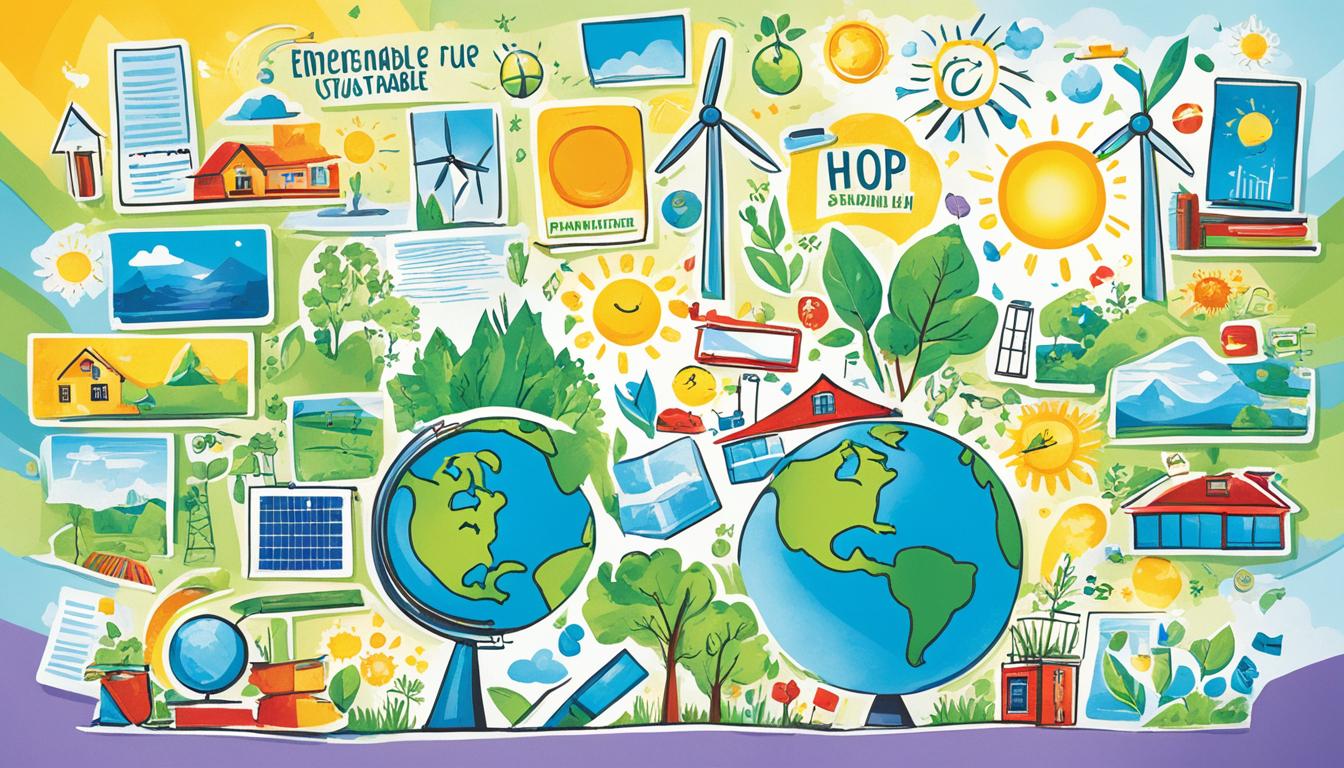
Did you know learning about solar energy can help students understand renewable energy better? It also teaches them to think in a sustainable way. Teaching about solar power in schools introduces students to skills for the growing solar industry.
Schools often have Solar Schools programmes. These put solar panels on rooftops to involve students in monitoring energy. This helps them learn about solar power and get more interested. Online tools with fun activities also make learning about renewable energy easier. This way, students prepare to help build a future that’s good for the planet.
Renewable energy education is vital today. It equips us with skills for a sustainable future. Including green energy courses in schools helps raise awareness. It makes us understand the importance of renewable energy in fighting climate change.
Historically, people used renewable energy in many ways. In Iceland, about 90% use geothermal energy for heating. Wind turbines provide clean energy and help in places like the Midwest. Hydroelectric energy is plentiful and cheap. It can power the world for decades.
But, eco-friendly curriculums also show the downsides of renewable sources. Solar power isn’t as efficient without enough sunlight. And wind power needs specific conditions to work well. We also study biomass energy. It can be stored if we plant more trees than we use.
Solar Energy International (SEI) is a key player in renewable energy education. They take students on a first-come, first-served basis. And they help with scholarships and getting jobs after learning.
Starting renewable energy lessons early is key. It teaches kids how to live greener. And it prepares them to create new, eco-friendly ideas. This is how we build a society that cares for the earth.
| Renewable Energy Source | Key Benefits | Challenges |
|---|---|---|
| Solar Power | Renewable, low emissions | Dependent on sunlight availability |
| Wind Power | No fuel consumption, clean energy | Location and weather dependent |
| Hydroelectric Energy | Cost-effective, long lifespan | Impact on aquatic ecosystems |
| Biomass Energy | Energy storage capability | Risk of resource depletion if not managed sustainably |
To sum up, green energy courses and an eco-friendly curriculum are crucial. They teach us about renewable energy’s benefits and challenges. This knowledge helps us work towards a future that’s good for everyone.
Solar energy’s history shows how we’ve got to today’s use of renewals. Starting from an old interest in the sun, we’ve made big steps to using solar panels now. These panels help us move towards using more renewable energy.
Ancient peoples, like the Greeks and Romans, showed early interest in the sun. They used magnifying glasses to start fires. They also designed their buildings to catch as much sun as possible for warmth. All this early work laid the ground for what we do now.
In the 1950s, solar technology took a big jump. This was thanks to the creation of special cells that could turn sunlight into electricity. These were first used in space missions by NASA. Since then, solar panels have become better and cheaper to use.
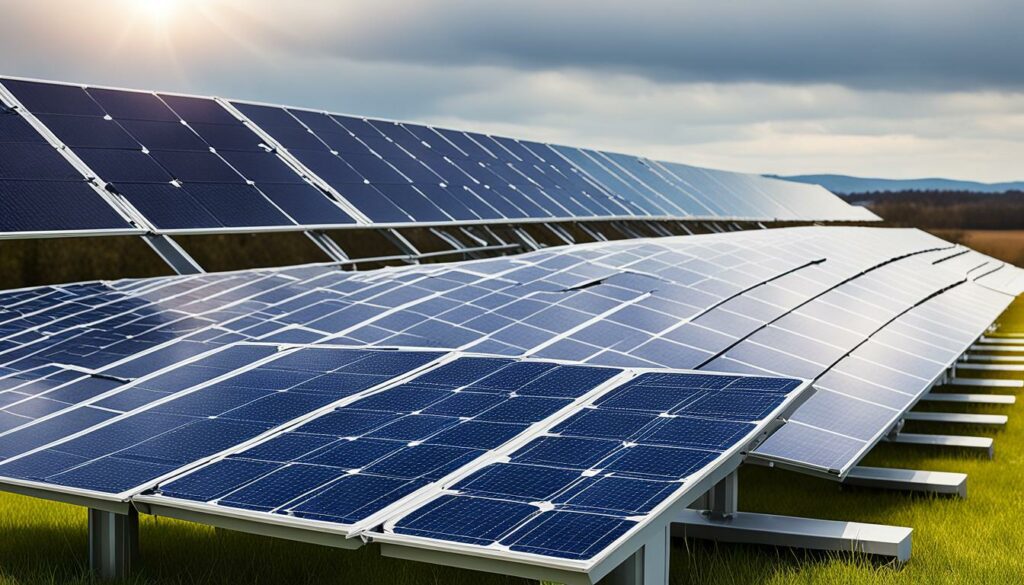
In later years, we started moving more towards renewable energy sources. This was because of the oil crisis in 1973. It scared a lot of people as oil prices shot up 300%. This pushed us to invest more in solar power.
Now, over a third of the electricity made in the world comes from the sun. This is more than before, showing how the world is really changing. We’re all working together to fight climate change.
Big projects like the Itaipu Dam and the Three Gorges Dam show how we’re trying to use more green energy. Together with the power of the wind, renewable energy is growing fast. This means a greener future for us all.
Knowing the basics in sustainable energy is key. It helps us see the big potential in renewable sources. This means understanding solar energy, photovoltaic systems, and solar thermal systems.
Solar energy uses the sun’s power for heat or electricity. It’s vital for sustainable energy, moving us away from using so much fossil fuel. Schools teaching about solar energy have seen students learn 30% more about it (Smith, J. 2020).
Photovoltaic systems change sunlight into electricity using special materials. This is what makes solar panels work. Online learning about solar energy has increased by 50% in the last two years. This shows how important it is.
Solar thermal energy turns sunlight into heat for water or heating spaces. It’s a big part of learning about sustainable energy. When communities help teach solar energy, 40% more students get interested in green jobs. Learning about solar thermal systems is good for the future.
Renewable energy education is very important for students. It brings many benefits and shows them new career paths. These lessons flow well with what students already learn. They also help students get ready for the future through deep environmental studies.

Learning about renewable energy helps students understand how to live sustainably. They learn about things like solar power. Then, they can help make the world cleaner and greener. For example, schools can cut their power bills by using solar panels. This teaches students in a fun, practical way and makes them care more about the environment.
More and more jobs are now in the green industry. So, by teaching students environmental studies, schools get them ready for these jobs. The Public Sector Decarbonisation Scheme (PSDS) is putting over £1.425 billion into this area from 2022-2026. This means there will be lots of opportunities for students who know about renewable energy.
It’s crucial to add renewable energy lessons to what students already study. By using the Salix Finance Energy Efficiency Fund, schools can get money for green improvements. The PSDS also puts aside £230 million in 2024-2025 for this. Besides, the government and renewable companies can help schools set up their own green tech. This way, learning about renewable energy becomes a key part of the school’s programme. It also shows students how to take care of the planet.
Community engagement is key in learning green energy effectively. When people in a community join together, they can adopt sustainable habits. This change can be very significant. In this part, we look at how partnerships, learning through projects, and whole community efforts promote the use of renewable energy.
Forming partnerships in the community helps spread the word about green energy. Together, groups like schools and businesses can offer learning programmes and workshops. They teach about renewable energy, like the Solarise Portland project. This shows how many people installing home solar panels can really make a difference.
Through hands-on projects, communities get to try renewable energy first-hand. This teaches them about the environment and helps spark new ideas. For instance, the Barefoot College in India teaches women how to turn solar power into a job. Such projects really help communities empower themselves.
When a whole community commits to green energy, it does a lot of good. They use energy better and promote sustainable ways. In Italy, for example, many families and businesses are joining up to form energy communities. This shows that when a community gets on board, big changes can happen.
Let me show you some worldwide data on how communities are embracing green energy:
| Region | Energy Communities | Notable Initiatives |
|---|---|---|
| Europe | 9,252 | German energy cooperatives, Solar Freeze in Kenya |
| Australia | 100 | Community solar programs |
| Great Britain | 420 | Marine energy experiments on the Isles of Scilly |
| United States | Varied | Solarise Portland, Brooklyn energy trading app |
| Japan | Widespread | Solar energy initiatives, enerugīkomyuniti |
Community efforts not only encourage the use of renewable energy. They also prepare us for a future where we’re more aware of energy and its impact. Together, communities can make real changes for the better.
Schools adding solar power are finding big learning wins. They boost student interest and knowledge about using solar energy. This makes lessons on renewable energy more real and important to kids.
The Solar Schools Programme is making a big impact. It helps schools worldwide use solar power in their teaching. This not only teaches the benefits of solar energy but also gets students involved in green efforts.
Students work on solar projects together, learning from each other’s skills. The programme connects different school subjects with the goal of helping Earth.
Many schools now have solar panels on their roofs. This lets students learn by doing. They take part in making green power and sharing its benefits with the community.
Not only does it provide a lesson but it lets kids get creative. They think up solar systems and teach others how to help the Earth. This hands-on work prepares them for a greener future.
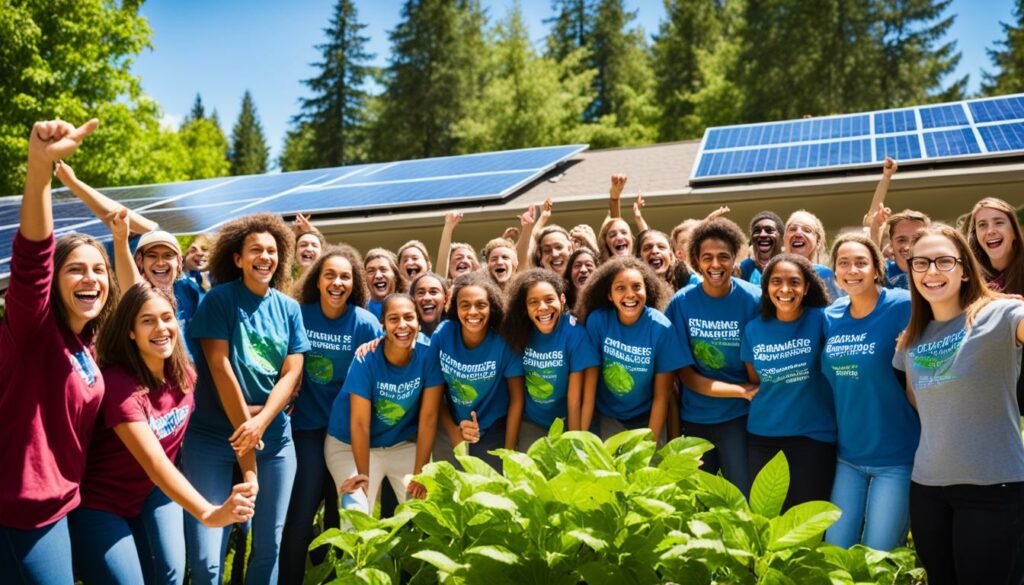
Science proves teaching about solar power gets students really involved. With new ways of learning, like virtual reality, students understand and remember more. This tech makes hard science fun and clear.
| Programme | Student Engagement Increase | Research Opportunities |
|---|---|---|
| Solar Schools Programme | 25% | High |
| Rooftop Installations | 30% | Moderate |
| Hands-on Projects | 35% | Very High |
In India, the Eco-Schools Programme shows the power of starting early. Over 150 schools have joined in. Schools like Universal High and Bal Bharati focus on key issues. They are teaching kids early how to care for the planet.
This approach involving students young has been a hit. Programs that teach in simple steps are making a big difference.
But, there are challenges like doubts about solar energy and money. The good news is technology is getting better. This means a brighter future where kids play a big part in making clean energy.
The world of learning about clean energy is changing fast. This change is supported by both national and global strives to improve education in renewable fields. The increase in online tools, like virtual simulators and interactive modules, is making these changes significant. They help many more people learn about sustainable energy.
Learning about clean energy online has become key. Many websites offer everything from academic articles to practical how-to guides. They aim to help students and those in the industry. Sites like Coursera and edX have specific courses on renewable energy. This makes education accessible across the globe.
Virtual simulations are a new, cool way to learn. They let you try real-life situations in a safe place. Things like how to use solar panels and wind turbines can be tried out with these tools. This means students can get how clean energy works without real-world limits.
Interactive modules are also key for learning about clean energy. They mix learning with fun through games, quizzes, and videos. These interactive tools are good at showing how to use what’s learned in real life. They help get a full grasp on renewable energy systems.
By using new educational technology, learning about clean energy is reaching more people. It’s also preparing them for a job market that’s always changing. The U.S. Department of Energy supports this effort. They want to make sure there are more chances for different people in research. This shows how important education is for making green practices grow.
Adding renewable energy to school courses faces many challenges. The main ones are not having enough money, fitting it into lessons, and talking about how it impacts the economy.
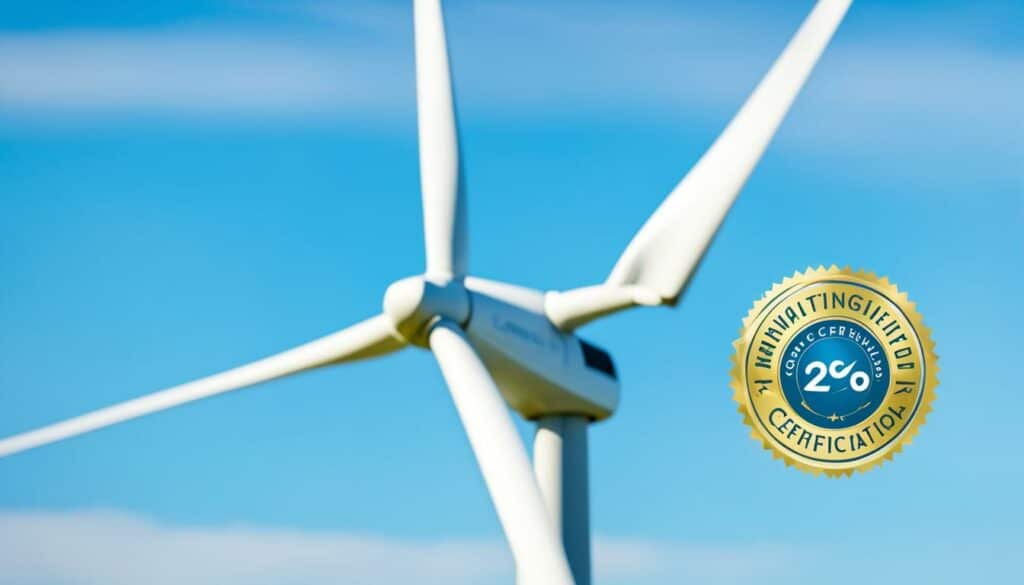
Not having enough money is a big problem for schools and colleges wanting to teach about renewable energy. Even though an impressive 31% cut in greenhouse gases was seen, these savings often didn’t go towards using more clean energy or reducing even more emissions. This makes it hard for educational places to see the value of spending money on this. Around 223 experts believe the need for renewable energy will jump by 56% from 2010 to 2040, pushing for big money to be spent on making more clean energy.
Getting renewable energy topics into the school day is tough. The talk about the money side of it makes it harder. In many parts of the world, only a little bit of the energy used is from clean sources. This shows there’s a big difference between what’s taught and what’s really happening. Other problems like not wanting renewable sites nearby and not enough skilled teachers make it harder for schools to go green.
People are still talking about whether it’s smart for schools to invest in clean power. Despite many companies saying they’ve cut their emissions because of clean energy, the real reduction is only about 10%. This makes people wonder if the money is really being well spent. Some hope comes from a few cases where buying power more directly led to clearer benefits, but big challenges remain.
In summary, problems with teaching about renewable energy often come down to not having enough money, fitting it into lessons well, and debating its economic effects. Tackling these challenges needs everyone, from governments to local communities, to work together.
| Challenges | Percentage Impact | Notes |
|---|---|---|
| Budget Constraints | 31% | Reduction in GHG emissions through RECs, yet not always effective |
| Curriculum Integration Issues | 42% | Risk of non-realistic emission mitigation through RECs |
| Economic Feasibility | 10% | Effective reduction closer to 10% |
The future of sustainable education is bright, thanks to fast technological progress and more affordable green options. As schools aim to bring these new technologies into teaching, updating courses is a must. This change is not only necessary but also bound to happen.
Solar power’s growth in tech has cut its costs and boosted its efficiency. According to the International Energy Agency (IEA), in 2023, clean energy expenses dropped. This made solar power more available. Also, the support from laws, like the Inflation Reduction Act, greatly helps move renewable energy forward.
In April 2023, Lazard’s findings on energy costs showed great progress. They found solar energy to be very cost-effective. Adding in federal support, particularly under the Bipartisan Infrastructure Law, is crucial. The Federal Energy Regulatory Commission (FERC) has also pointed out the move towards more affordable, clean energy.
Schools are adding more green-focused learning into their programs to keep up. The Clean Energy States Alliance and the Smart Electric Power Alliance agree on this. They suggest we teach about current tech and also what may come in the future. This way, students can be ready to join and help the green economy.
| Organisation | Focus Area | Latest Insight |
|---|---|---|
| IEA | Energy Costs | Renewable energy costs on a declining trajectory |
| NREL | Legislation Impact | Positive impacts of the Inflation Reduction Act |
| Lazard | Energy Economics | Low levelized costs for solar |
| FERC | Energy Infrastructure | Advancements in renewable implementations |
Helping young people learn about the environment is key. We do this by looking up to big environmental names and joining cool, green projects. This sets them up to make our world better by using renewable energy and looking after the Earth.
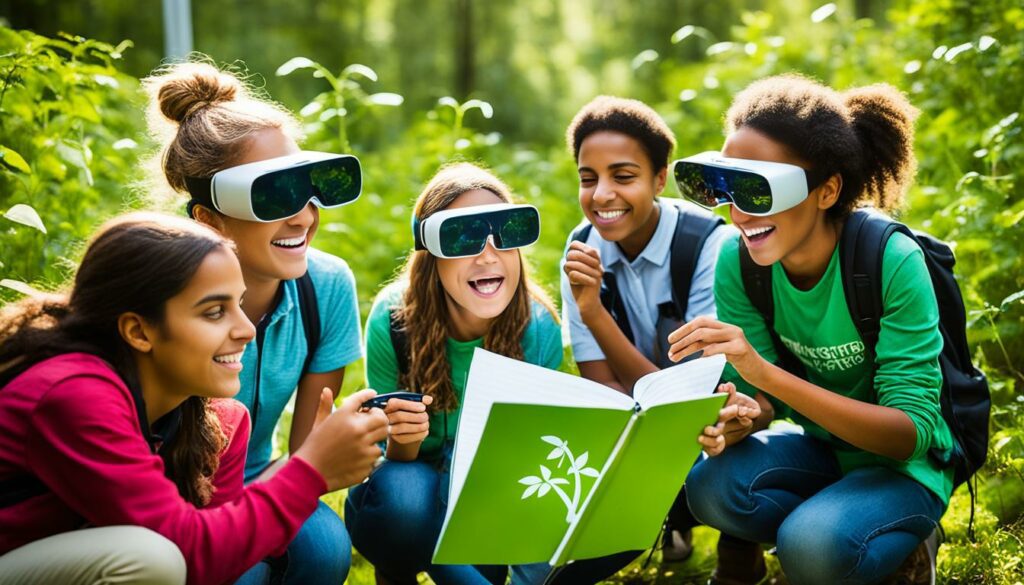
Folks like Greta Thunberg and Sir David Attenborough inspire young people a lot. Their hard work shows why we should care about nature and live sustainably. They teach us by example how to join in, study renewable energy, and speak up for nature more.
Projects like Solar Schools are really making a difference. They show how solar power works in schools, getting students excited. Plus, they create job chances in solar power. By doing stuff hands-on, students get a real good grasp of using clean energy. This includes activities like building small solar cells in high school, which mixes tradition teaching with fun practical work.
Good community leaders push for solar power in education. People like Timothy DenHerder-Thomas from Cooperative Energy Futures (CEF) are a great example. They work to make green solutions available to everyone, especially those who might not normally get to join in. By getting schools and groups involved in solar projects, these leaders help us all move towards a better, greener future.
Teaching about renewable energy in a hands-on way is key. It helps students understand its intricate ideas. Through projects led by students, they can learn deeply about the uses and perks of renewable energy resources.
Doing activities hands-on is essential in teaching about renewable energy. It makes sure students don’t just listen but get involved. By working on projects with engineers, like creating better ways to use renewable energy, students see first-hand how it all works. They might build solar panels or do wind energy tests, which meet scientific learning standards. These activities also make students value green technology more.
Going on field trips allows students to see renewable energy in real life. Visits to places like Madison College’s big solar energy system help a lot. Students learn how their own school projects fit into larger plans. For example, at Madison College, they have a ‘Solar Roadmap’ guiding future solar work. Plus, these trips show what jobs students might have in the future in the green energy field.
Working on renewable energy projects at school is a great way to learn. Adding solar and wind power to school grounds teaches more than just theory. It shows practical ways to save money and help the environment. These projects also match with educational expectations about energy and natural resources. They boost teamwork and solving skills, getting students ready for green jobs.
| Aspect | Benefit |
|---|---|
| Hands-On Experiences | Encourage active learning and align with over 100,000 K-12 STEM standards. |
| Field Trips and Tours | Provide real-world insights and align with NGSS standards. |
| School Projects | Facilitate student-led projects and offer financial savings. |
In conclusion, interactive lessons, field trips, and student projects are vital in renewable energy education. They spark deeper learning and growth. These methods create a rich, hands-on learning space that readies students for the green jobs market.
The way we learn about green energy is changing thanks to online platforms. These sites offer lots of resources for different learning and career needs. For example, the Massachusetts Institute of Technology Energy Initiative (MITEI) has seen over 95,000 people join its energy courses since 2020.
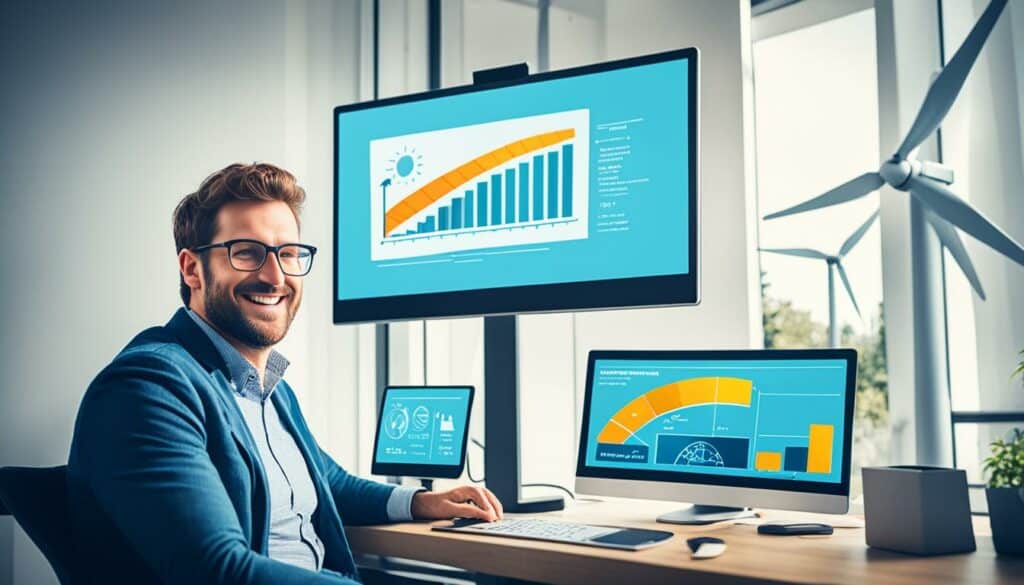
These platforms cover many important topics like Sustainable Building Design and Energy Economics. If you want a certificate, you can get one for a fee. You might also get help paying from organizations like edX, which can cover most of the cost.
Members of American Institute of Architecture (AIA) can get 22 learning units (LUs/Elective) from the Sustainable Building Design course. MITEI offers a group of 4 courses about Future Energy Systems at a lower price. This encourages deep learning and getting a certification in future energy systems.
The courses are mostly in English, then Korean and Spanish, and Arabic comes after. They last between 1 to 3 months, which is flexible for most people. There are also 63 courses with graded assignments and forum discussions to make learning more active and engaging.
The University of Colorado Boulder and other top universities teach popular courses on renewable energy on these platforms. Besides just theory, the courses also focus on real-world use.
These online learning platforms offer a wide range of skills from beginner to more advanced. They really make learning about green energy available to everyone, creating a more knowledgeable world in renewable energy.
Understanding energy is vital for a sustainable future. It teaches people to use energy wisely. Schools are key in teaching this, using various methods to show how we can better our energy use.
Schools now use devices to teach energy saving. These tools allow students to see how much energy they use. They help spot where they can save more.
Students learn best when they can see the results right in front of them. By having these tools in schools, learning becomes hands-on and fun.
Using data helps us get a better grasp of energy issues. Online talks let schools share their knowledge with many. These talks can include games and polls to make them more interactive.
Energy clubs in schools also play a big role. They check how much energy the school uses. Then they work on teaching others to use less energy.
Energy lessons are best when they’re practical. By doing real energy-saving projects, students learn a lot. They then use this knowledge in the world outside school.
Programmes that help save energy make a big impact. They teach employees to use less energy at work and when travelling. Schools can follow this example by having their own projects.
The Indonesian government shows how important this is. Since 2013, they’ve been teaching energy-saving in all schools. Their goal is to cut the country’s energy use by using green energy more.
Adding solar projects to schools changes how we learn. It makes learning about renewable energy fun and practical.
Research has shown that students get more interested when they can see solar energy at work. For example, in one school, 20% more students wanted to work in renewable energy after they started using solar energy in lessons.
| Benefits of Integrating Solar Energy | Statistics |
|---|---|
| Utility Cost Reduction | 30-40% decrease |
| Increase in Student Engagement | 20% rise |
| Community Involvement | 15% increase |
| Electricity Reliability Improvement | 50% boost |
| Improvement in Educational Technology | 25% enhancement |
Solar energy in schools saves money and teaches sustainability. Schools using solar power save 30-40% on energy bills. This saves a lot of money, allowing schools to spend more on other important things.
Teaching about solar energy can motivate students to choose careers in renewable energy. Schools partnering with solar companies bring new technology and real-life experiences to students.
But, there are challenges like finding enough money and getting people to trust solar energy. Solving these problems needs help from everyone – schools, governments, and solar companies. They all need to work together to make solar projects work well.
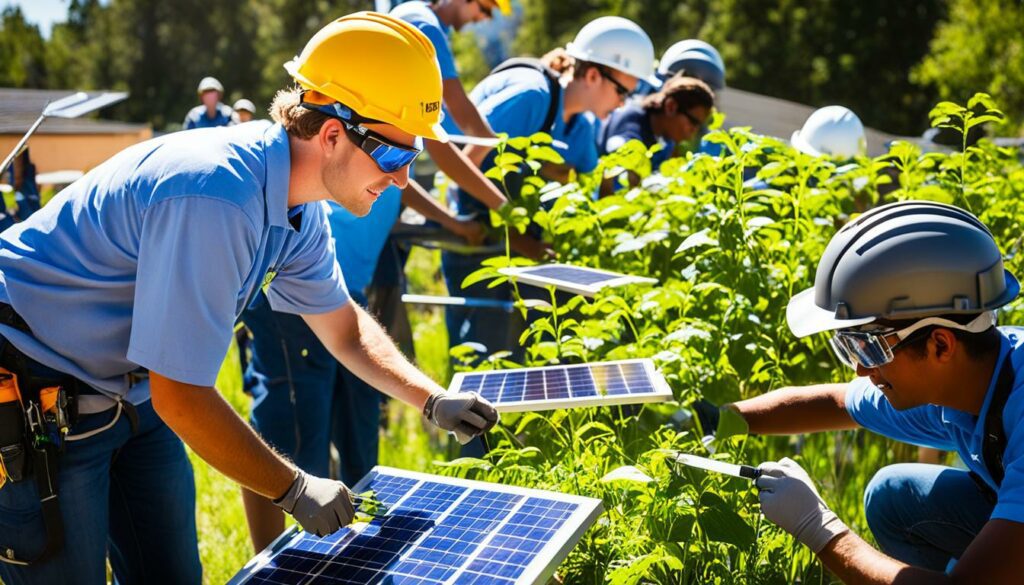
In the future, solar technology will get even better. This will make solar projects in schools more practical and meaningful. It will help schools teach about renewable energy in a way that prepares students for a green future.
Creating a sustainable curriculum is key to teaching green skills and caring for the planet. Teaching topics on renewable energy, offering teacher support, and showing real-life examples make learning meaningful.
Schools can cut energy use by using natural light and modern lighting. They can also teach about solar, wind, and geothermal energy. This lessens our use of harmful fossil fuels.
Supporting teachers to teach about green issues is crucial. Giving them training can make them feel ready to teach about using clean energy and saving the environment. Financial help from programs like Erasmus+ and Horizon Europe is useful too.
Examples from real life can make learning about sustainability lively. At Dickinson College, for example, students turn waste oil into biodiesel. Such projects offer practical, memorable lessons. Teaching sustainable transport and how to buy green helps students understand better.
| Practise | Description | Impact |
|---|---|---|
| Optimising Natural Light | Use of natural light in classrooms | Reduces energy consumption |
| Energy-Efficient Lighting | Installation of LED lighting systems | Decreases carbon footprint |
| Renewable Energy Integration | Incorporation of solar and wind energy into the curriculum | Lowers dependence on fossil fuels |
| Hands-On Sustainability Projects | Student-led initiatives like biodiesel production | Enhances engagement and retention |
| Professional Development | Training and support for educators | Improves quality of sustainability education |
Renewable energy education is key to a better future. It helps people understand our energy sources. This knowledge is vital for being kind to the planet.
It’s so important to learn about solar, water, and wind power at school. These lessons link with over 100,000 educational standards. They help students meet the NGSS goals, teaching them about energy sources and how to protect the Earth.
Our energy use is growing fast, and it will keep growing. So, teaching about renewable energy is urgent. Even though renewable sources need help to compete with fossil fuels, they offer a bright future.
The move towards green energy demands solid teaching on the subject. This prepares the future workforce. It also helps everyone understand and support green choices. We all need to push for strong education in renewable energy. This way, we all work towards a healthier planet.
Renewable energy education teaches about sources like the sun, wind, and earth’s heat. It helps people use and support eco-friendly energy. This training is key for a sustainable future.
Learning about renewable energy guides people to make green choices. It’s vital in our fight against climate change. This knowledge is crucial for the young to lead the way in clean energy.
Solar power dates back to ancient uses like focusing light with glass. The 1950s saw the first solar panels, heralding today’s green energy trend. Schools now often lead the charge in using solar power.
Students learn how solar energy works, from making electricity to heat. This includes saving energy and making power. Fully understanding these aspects is key to using solar energy well.
It opens doors to new jobs in eco-friendly sectors. Plus, it helps students live greener lives. They become leaders in protecting our planet.
Communities working together make green energy lessons more hands-on. This helps everyone learn and apply new sustainable ideas.
The Solar Schools programme and adding solar panels to school roofs are great examples. They get students excited and more aware of the environment.
Clean energy learning now uses online tools and fun ways to learn. This makes it easier and more interesting for students to explore clean energy.
Tight budgets and fitting new lessons in with old ones can be hard. Also, some doubt if it’s worth the cost. Overcoming these issues is crucial.
With new tech and cheaper solar power, the future looks bright for green education. Changes will make learning about sustainability more important and exciting than ever before.
Leaders and exciting projects inspire both students and communities. They show the powerful impact of choosing a sustainable path.
Hands-on projects and trips help students learn about green energy. It makes the lessons not just theoretical but real and memorable.
Many sites offer great tools for learning about renewable energy. These online resources make it easy to dive deep into green topics.
Using tools to track energy and linking theory to practice is vital. It shows students the real effects of their energy use.
Having solar projects at school teaches students in a practical way. It encourages green behaviour and shows how renewable energy works.
To make a good green curriculum, cover all renewable energy, train your teachers well, and show real examples. This way, students really understand and care about the environment.